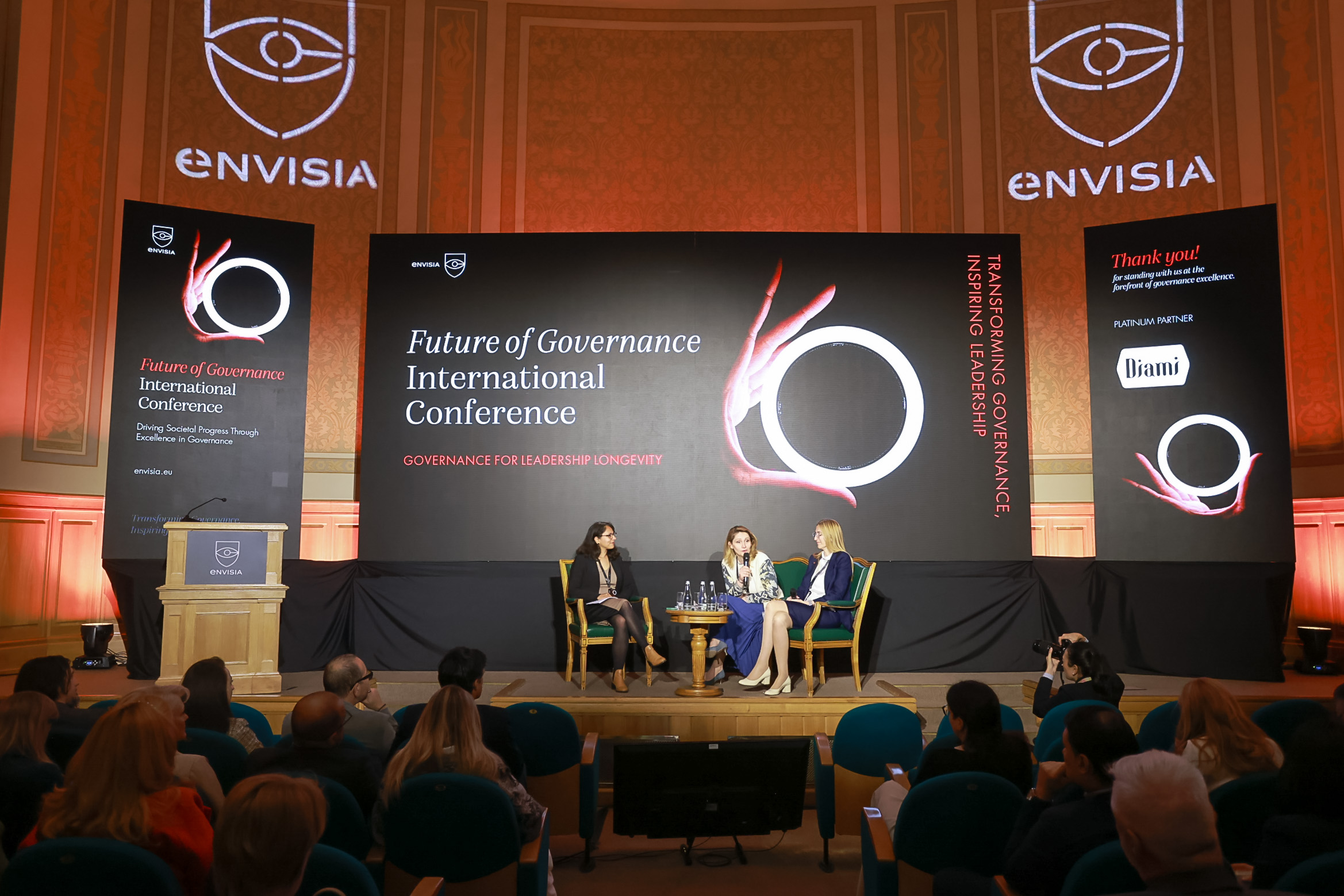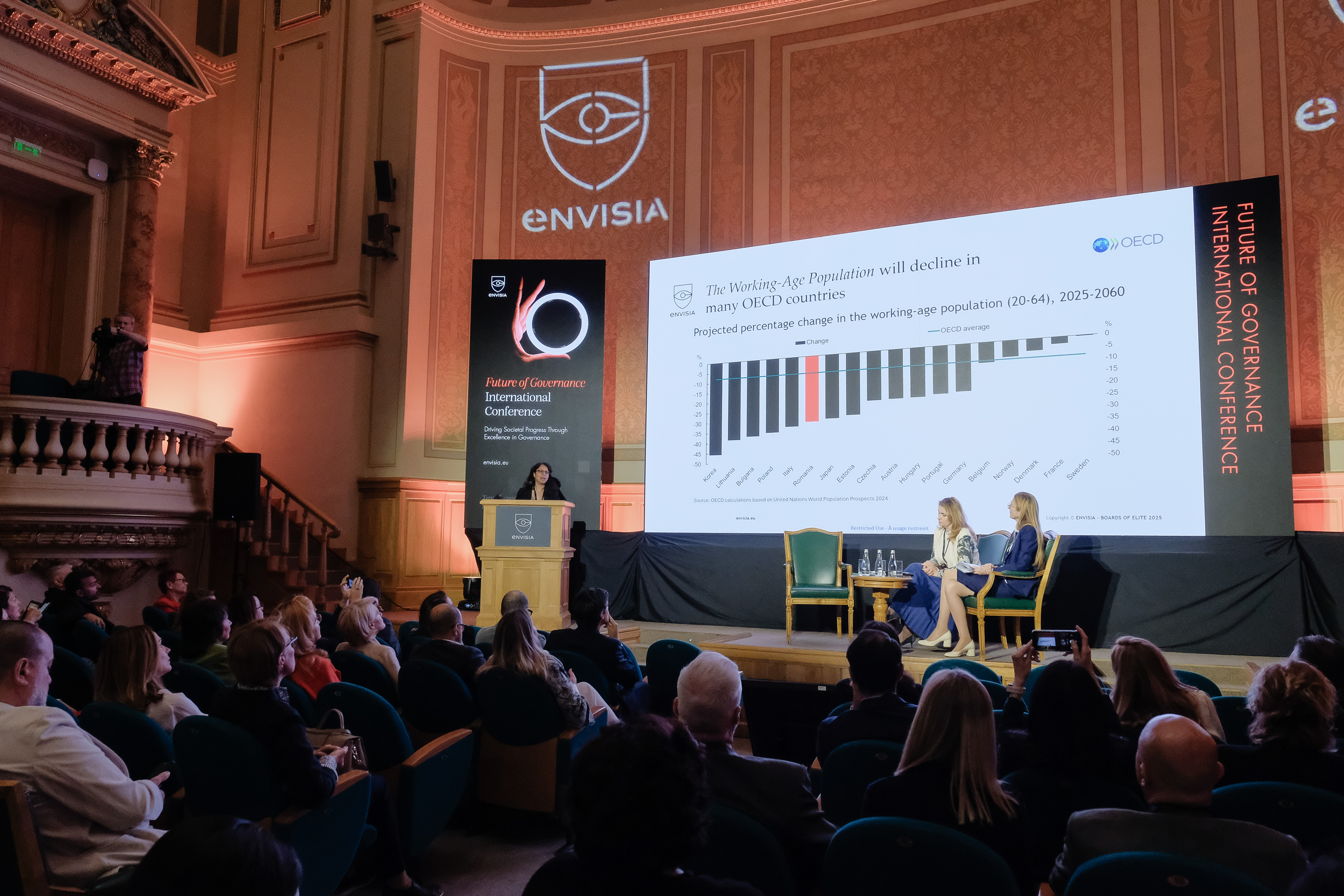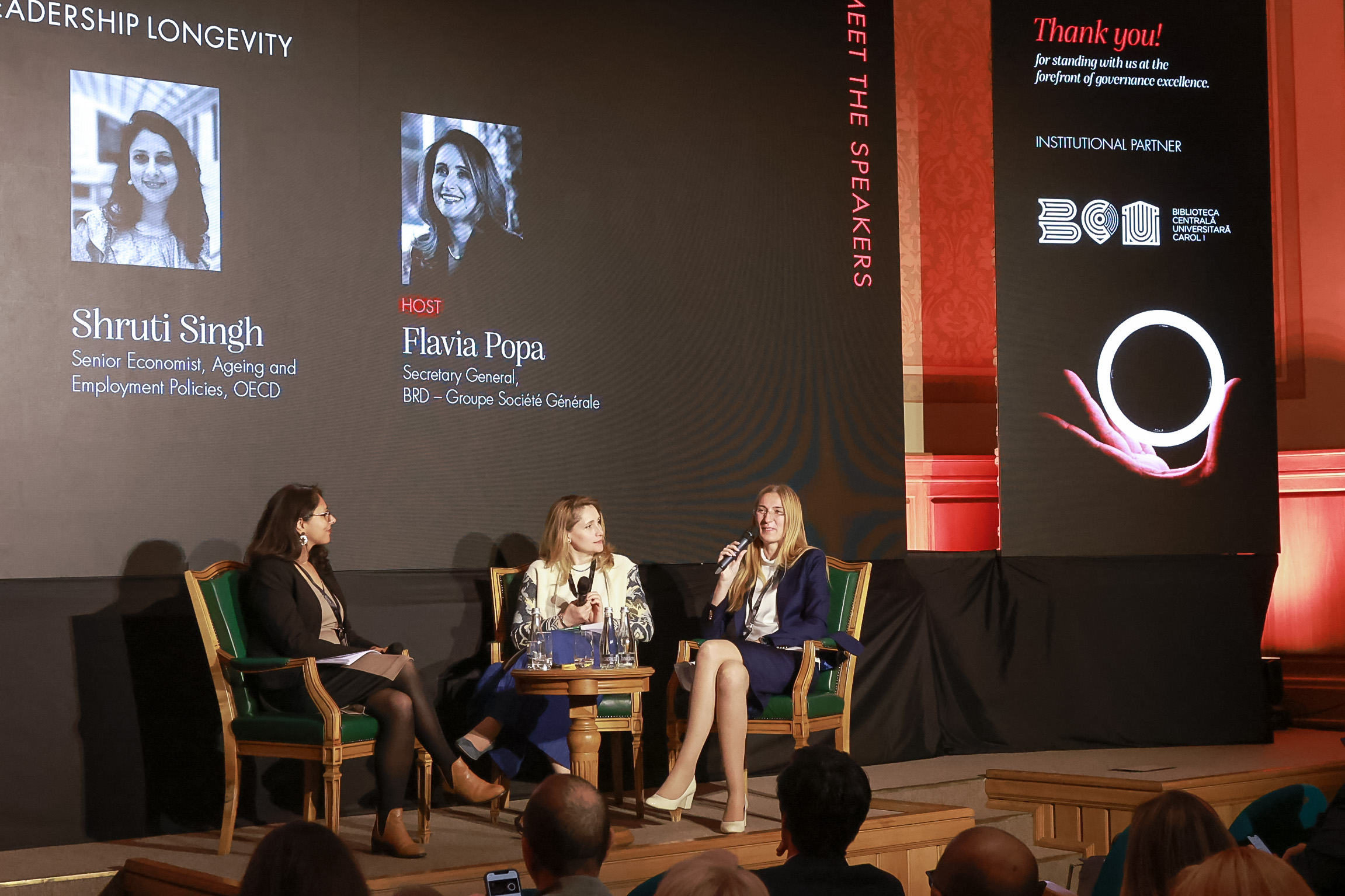Leadership Longevity: From Stereotype to Strategic Advantage

The future of work isn’t only about AI and automation — it’s also about demographics. As populations age and careers stretch into new phases of life, a quiet revolution is underway. One that challenges deep-seated assumptions about who belongs in leadership and what it means to grow a career.
This demographic transformation isn’t just a human resources concern — it’s also a boardroom issue. And at the Future of Governance International Conference, hosted by Envisia on May 20, that message came through loud and clear. In a session that reframed aging as an economic and strategic priority, Shruti Singh, Senior Economist at the OECD, joined Alina Popa (CFO, OMV Petrom) and Flavia Popa (Secretary General, BRD Groupe Société Générale) to discuss how organizations can adapt governance, culture, and strategy to support longer, multistage careers.
Their core insight? Leadership longevity isn’t a liability — it’s a competitive edge.
The Demographic Wake-Up Call
Across OECD countries, the working-age population (20–64) is shrinking, while the 65+ segment is growing rapidly. More, according to the World Health Organization, by 2030, approximately 1.4 billion people globally will be aged 60 years or older, representing roughly one in six people worldwide; this number is expected to reach 2.1 billion by 2050. An increasing number will remain active in the labor market, with two possibilities: add pressure and lower the GDP per capita if employment rates remain constant, or reshaping how we think about productivity, retirement, and leadership.
These trends aren't theoretical — they’re here! And if businesses fail to adapt, they risk losing institutional knowledge, workforce stability, and competitive edge. But if they do adapt, leadership longevity becomes a powerful advantage.
In response to these shifts, professional development tailored to today’s boardroom realities is essential. Envisia addresses this through programs like the Henley Postgraduate Certificate in Board Practice and Directorship, developed in partnership with Henley Business School—one of the world’s oldest and most respected institutions in executive education, holding triple accreditation (AACSB, EQUIS, AMBA). The program offers a global perspective and is designed for experienced board members and senior leaders operating in complex, international environments. Over 180 Romanian board professionals have completed this elite certification through Envisia. Applications for the 9th cohort are open until September 5th. More info
The Age-Performance Paradox
Despite overwhelming evidence that older workers perform as well — or better — than their younger peers, ageism is still alive and well. According to OECD, hiring managers often prefer candidates under 45, believing they’re more adaptable or tech-savvy. And yet, once hired, older employees prove equally competent and often more resilient.
This contradiction — between perception and performance — is what experts call the age-performance paradox. It’s not just a bias issue. It’s a missed opportunity.
Romania’s Demographic Challenge — and Opportunity
Romania is among the OECD countries facing a steep demographic shift, with projections showing a sharp decline in the working-age population (20–64) by 2060. At the same time, the 65+ population is expected to increase significantly, placing added pressure on social spending — particularly pensions and healthcare, which already absorb the bulk of public funds. In this context, retaining older workers and extending their participation in the labor market is not just beneficial — it’s essential for economic sustainability.
Yet Romania, like many countries, faces barriers: early retirement trends, underinvestment in adult training, and limited adoption of flexible work policies. The silver lining? These very gaps present clear opportunities. By implementing targeted strategies — mid-life career reviews, age-inclusive hiring, and upskilling programs tailored for mature workers — Romania can strengthen workforce resilience and unlock the economic potential of its experienced professionals.
Building governance capacity at the national level also requires accessible, accredited education rooted in local realities. That’s why Envisia, in strategic partnership with the Romanian-American University, developed the “Corporate Governance that Creates Value” program — the first nationally accredited board professionalization course in Romania. Designed in collaboration with the Bucharest Stock Exchange, it serves both public and private sector leaders, offering 6 ECTS credits and practical tools for responsible governance. Over 130 participants have already graduated, with the 11th cohort starting this fall. Applications are open until October 13th. More info.

Career Mobility is Key — But Rarely Encouraged
One of the most powerful predictors of long-term employability is career mobility. When effective, the mobility in one’s career is crucial for boosting labor market responsiveness to economic changes and for improved productivity. In short, discontinuity can be an opportunity for growth
OECD data shows that workers who make a job change between the ages of 45 and 54 are significantly more likely to still be employed at 60. Yet, mobility rates drop steeply with age: only 6% of workers aged 55–64 change jobs annually, compared to 17% of those under 30.
The problem? Structural barriers and internalized doubt. Older workers face hurdles like outdated training models, technological change, caregiving responsibilities, along with age, geographic immobility, health, and yes — bias. In addition, adding insult to injury, older workers are less likely to have age-friendly jobs. Many simply stop believing that change is possible. The OECD calls out the “implicit or explicit ageist attitudes that undermine the fluidity” of older workers’ career transitions and suggests a broad range of measures to support them. It also warns that the growing use of AI in recruitment and assessment risks embedding existing age biases into future talent systems — a challenge that requires intentional action and vigilant oversight.
Addressing these barriers is key to unleashing the potential of a massive and growing segment of the population – the older. Which should be of interest to both companies and governments facing the growing skill shortages characterizing ageing societies that don’t adapt. If mobility leads to better outcomes for individuals, the question becomes: how can companies and governments make it more accessible — especially for later-career transitions? In fact, individuals may be more open to change than employers assume. Even small signals of mobility support from organizations — like highlighting internal roles as open to all ages — can have a powerful impact.
Age diversity is a business advantage
With an ageing population and a multigenerational workforce becoming the norm, businesses must adapt. What happens when organizations take this step and break the cycle? They gain access to a stronger talent pipeline, enhanced workforce resilience, and higher productivity through knowledge continuity.
Intergenerational teams drive performance and companies with balanced age diversity report better decision-making, stronger mentoring culture, and improved adaptability. According to OECD research, increasing the share of older workers by just 10% leads to a measurable 1.1% boost in overall productivity. This uplift isn’t only due to individual contributions: 0.6% comes from direct effects, such as the performance of older employees themselves, while 0.5% stems from spillover effects, including knowledge transfer, mentorship, and stronger team dynamics. Organizations that foster age-inclusive environments benefit from a more resilient workforce, a stronger talent pipeline, and improved retention of institutional know-how — all critical drivers of long-term competitiveness. As Shruti Singh emphasizes: “Age-diverse workforces are not just inevitable — they’re a strategic advantage.”
In a tight labor market, retaining talent at all ages requires more than just good intentions. It demands:
- Flexible work models: Telework, phased retirement, part-time options — all of which are still underutilized.
- Upskilling and reskilling: Especially digital training tailored to older workers.
- Age-inclusive hiring: Skills-based recruitment processes that reduce bias.
- Proactive health support: From ergonomics to mental health services, especially for older workers balancing care duties.

The Value Shift: Experience vs. Training
A critical gap exists between what workers value (experience) and what employers prioritize (skills and adaptability). Employers now place a higher premium on recent training than on decades of experience — yet participation in training drops significantly after age 50.
The message for employees? Stay curious. The message for employers? Make learning accessible — and attractive — at every age.
The Future of Leadership is Age-Inclusive
Organizations that fail to adapt to demographic realities will face deepening talent shortages and widening skill gaps. Those that embrace leadership longevity and multigenerational strategy will have the edge — in innovation, loyalty, and resilience.
So, the question is no longer whether we should adapt to an aging workforce — it’s this: Can you afford not to?
In this context, what can business leaders do now to be future ready?
- First, run the numbers - what percentage of your workforce is over 50 and what are their engagement and promotion rates.
- Second, audit your recruitment and development practices - are they age-neutral or age-biased.
- Reframe leadership development - think beyond linear careers and identify leaders in their 50s and 60s who still have a decade of value to offer.
- Invest in longevity strategy: Not as a social gesture, but as a business imperative.
- Embed flexibility at the core: Flexible schedules, hybrid roles, consulting pathways — they matter, especially post-pandemic.
Recommended articles
Future of Boards & NED Careers
Future of Boards & NED Careers
ESG & Risk Oversight
Leadership, Boardroom Dynamics & Crisis Response
Governance & Board Effectiveness
Governance & Board Effectiveness
Leadership, Boardroom Dynamics & Crisis Response
Future of Boards & NED Careers
Governance & Board Effectiveness
Governance & Board Effectiveness
Governance & Board Effectiveness
Future of Boards & NED Careers
Leadership, Boardroom Dynamics & Crisis Response
Future of Boards & NED Careers
 BACK TO ARTICLES
BACK TO ARTICLES
 Facebook
Facebook Linkedin
Linkedin
